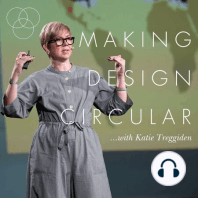27 min listen
Lauren Chang
ratings:
Length:
56 minutes
Released:
Aug 10, 2021
Format:
Podcast episode
Description
How does conservation differ from repair? How is it similar? How have the tenets and ideas of best practice with conservation changed over time?On today’s episode, I’m talking to Lauren Chang, a textile specialist, who spins, dyes, weaves, and writes about textiles on her website interstitial-spaces.com. She holds a B.A. in Art and Archaeology from Princeton University and an MA in Textile Conservation from the Textile Conservation Centre in the United Kingdom. Lauren worked as a textile conservator at the National Museum of the American Indian, Smithsonian Institution, the Los Angeles County Museum of Art, the British Museum, and the Art Institute of Chicago.We discuss:- How attitudes to repair differ between Chinese and American cultures.- How the tenets and ideas of best practice with conservation have changed over time.- The power dynamics at play in conservation between the people orchestrating the conservation and the people deciding what gets conserved and what doesn’t.- How we can start to repair some of those power imbalances within museums and within conservation.- The importance of ‘sitting in the discomfort of not knowing’, of holding two conflicting ideas at the same time, of nuance.… and more!Here are some highlights. The difference between textile conservation and domestic repair “Conservation is quite a rigorous and practical and theoretical discipline. So practically speaking, there are specifics like when you're stitching, you always move your needle or you place your pins through the interstices of the textile., so the spaces between the warps and wefts never split a thread. There’s also really stringent parameters around the material you select, so they don't cause damage just by sitting next to or how they age and degrade. There are also philosophical differences. You don't often choose what you repair. So for example, perhaps you work in a museum, it's usually exhibition driven. So you might be consulted for the choice of them looking at the condition, but the selection is really made by curatorial staff.”How opinions towards mending and repair have changed “There's a point in conservation where you learn everything. You learn different techniques, but you realize that no action is neutral, right? So you do one thing and that causes all these other problems, then you do another thing, and it causes another problem. But you still have to move ahead. Maybe you’re repairing to be thrifty or to be respectful of the environment, and I'm learning that my actions have all these different repercussions, but it doesn't mean we just stop. I feel like that's where the conversation is going, and I think it's really important because if you sit in the complexity of the discomfort, I think you understand the frameworks that lead us to this point.”Preserving the soul and culture of an item (in this case, dance regalia from Northern California)“It was really tense. But I remember Loren saying, ‘Oh, these pieces haven't been sung to or danced to in a really long time, and that's why they're in such bad shape. So he sang to them. He started telling me about the history and how they were made and how they were used and how that relates to the contemporary traditions in the community. And he moved the pieces as if they would be danced. And towards the end they dressed me in his aunt's regalia, which was such an honor, but also so incredibly moving. And I think these were all acts of preservation and care. And the power had really shifted because I only learned as much as they were willing to share. And they also brought up a lot of ideas about conservation for me because it was clear that I could learn to care for the materials, the physical aspects of the dance regalia, but it was also clear that I could not care for them in a way that actually preserved them. So it raised the question of what is my role as the conservator? What is best care or best practice? What are we conserving? And how do I fulfill my role in pro
Released:
Aug 10, 2021
Format:
Podcast episode
Titles in the series (42)
Lauren MacDonald: In the eighth episode of Series 01, Katie Treggiden talks to artist, designer and director of textiles studio, Working Cloth, Lauren MacDonald, about dying clothes using food waste. Lauren explains why she finds the term ‘natural dye’ problematic, how a box of penises put her off studying art (yes, you read that right!), the magic tricks she performs with red cabbage, and why avocados will turn your clothes pink not green. As recommended by Metro, The Week, Wallpaper and FastCompany. by Making Design Circular with Katie Treggiden
